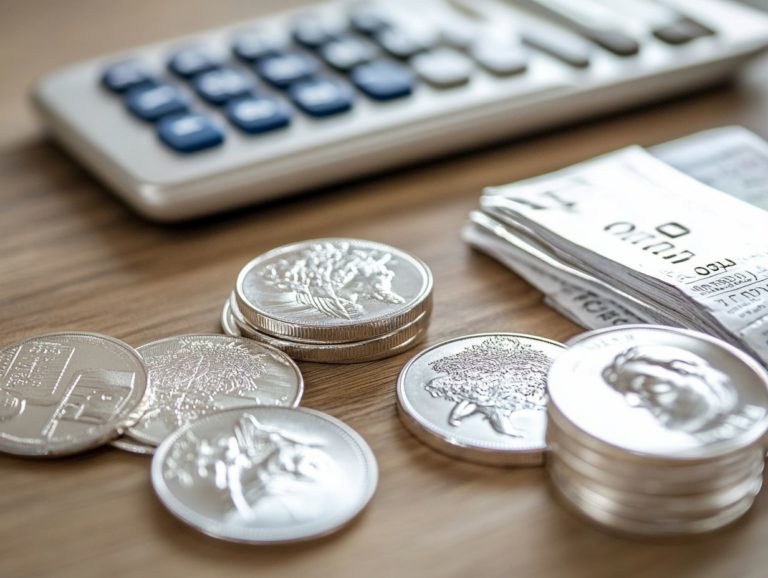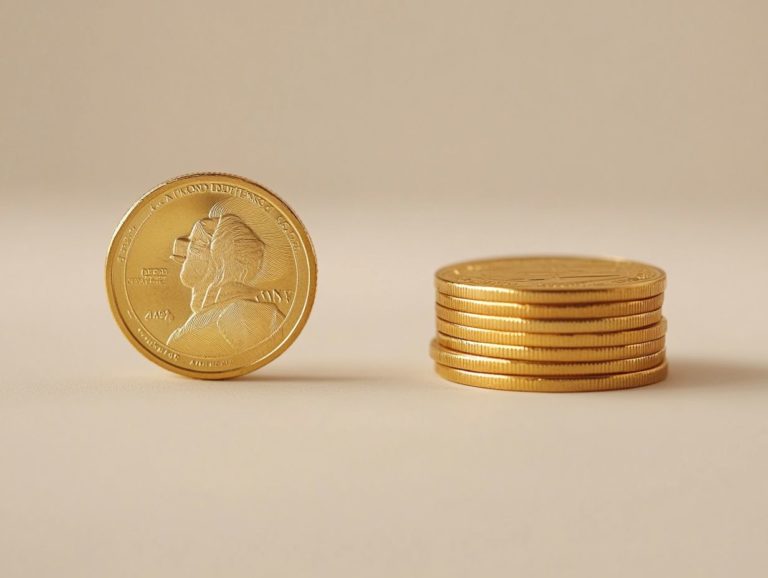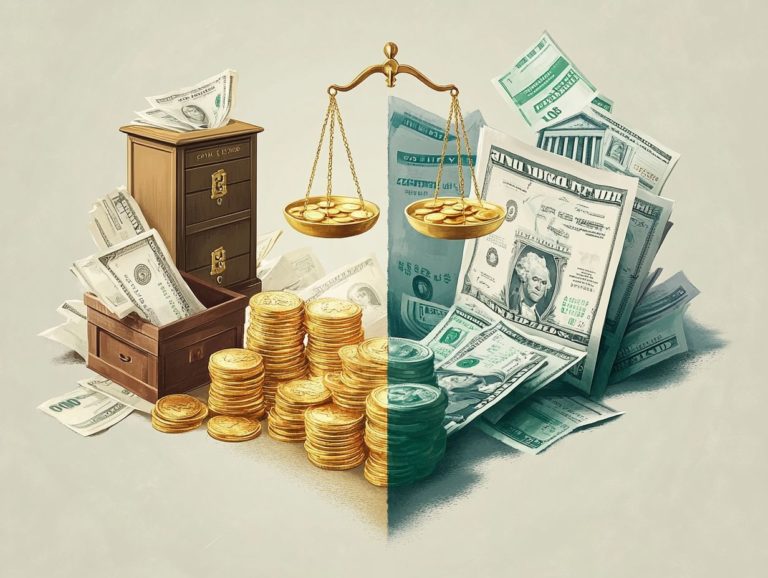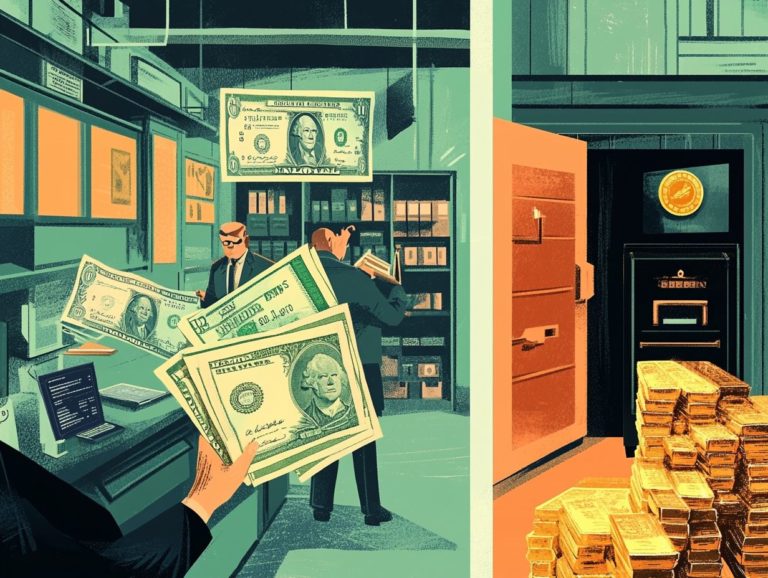5 Common Mistakes in Physical Asset Investing
Investing in physical assets opens up a world of exciting opportunities, yet it also carries its own set of challenges.
This article delves into five common mistakes that could derail your investment journey, from neglecting due diligence to turning a blind eye to market trends.
It covers essential concepts such as what physical asset investing truly entails, the various types of assets at your disposal, their potential benefits and risks, and strategies to effectively mitigate those risks.
Whether you re a seasoned investor or just dipping your toes into the market, grasping these elements is vital for successful asset management.
Contents
- Key Takeaways:
- 1. Not Conducting Proper Due Diligence
- 2. Ignoring Market Trends and Conditions
- 3. Overlooking Maintenance and Repair Costs
- 4. Focusing on Short-Term Gains Instead of Long-Term Returns
- 5. Not Diversifying Your Portfolio
- What Is Physical Asset Investing and How Does It Work?
- Frequently Asked Questions
- What are the 5 common mistakes in physical asset investing?
- Why is conducting proper research important in physical asset investing?
- How does diversifying your portfolio help in physical asset investing?
- What are the consequences of overpaying for assets in physical asset investing?
- Why is it crucial to keep track of market trends in physical asset investing?
- How can underestimating maintenance and upkeep costs affect your physical asset investments?
Key Takeaways:

- Proper due diligence is vital in physical asset investing to avoid risks and maximize returns.
- Ignoring market trends and conditions can lead to poor investment decisions and losses.
- Maintenance and repair costs should not be overlooked, as they can greatly impact asset profitability.
1. Not Conducting Proper Due Diligence
Not conducting proper due diligence is one of the most significant mistakes you can make as an investor. It undermines your ability to craft a robust investment strategy that aligns with your financial goals.
This is especially important given the ever-changing landscape of market trends and volatility that can impact your investment outcomes.
Thorough due diligence means meticulously evaluating market trends to gain valuable insights into potential opportunities and risks. You must also be mindful of how emotions and cognitive biases can shape your decision-making.
Investment firms are essential in this process; they provide the research and analysis you need to make informed choices. Techniques like evaluating strengths and weaknesses can significantly enhance your understanding and evaluation.
By systematically gathering and analyzing relevant data, you can minimize risks and boost your chances of achieving favorable returns.
2. Ignoring Market Trends and Conditions
Ignoring market trends and conditions could lead you to suboptimal investment returns. This hampers your ability to adapt your financial planning and risk management strategies.
By staying informed about these trends, you position yourself to make timely decisions that align with your financial goals. For instance, monitoring key indicators like interest rates and inflation rates can provide invaluable insights into market health.
When interest rates dip, you might find it advantageous to pivot towards equities with the potential for higher returns. Rising inflation could nudge you toward commodities or real estate as a safeguard.
Grasping these dynamics empowers you to craft winning strategies!
3. Overlooking Maintenance and Repair Costs
Overlooking maintenance and repair costs can significantly impact the total cost of ownership for your investments. This can ultimately lead to diminished asset performance over time.
Effective maintenance strategies are essential for prolonging the lifespan of your assets and optimizing their performance. For example, implementing regular inspections can help identify issues early, reducing costly repairs down the line.
Budgeting for these expenses is critical. You should allocate specific funds for maintenance to avoid unexpected financial strain that could disrupt your overall plans.
By integrating routine maintenance schedules and setting aside reserves for potential repairs, you not only safeguard your investments but also enhance the value of your assets. This paves the way for improved investment outcomes.
4. Focusing on Short-Term Gains Instead of Long-Term Returns

Focusing on short-term gains rather than a long-term investment strategy can lead to emotional decision-making that compromises your investment objectives. This often results in significant losses over time.
Maintaining a long-term investment perspective is vital for ensuring both your financial stability and peace of mind. It s easy to react impulsively to market fluctuations. For example, deciding to sell off assets after a sudden dip in stock prices may seem like a smart move in the moment, but it can erode your potential for growth.
Here are some effective strategies to manage emotional responses:
- Set realistic financial goals,
- Diversify your portfolio, and
- Regularly review your investment strategy.
If you panic and sell during a market downturn without considering the underlying fundamentals, you risk missing out on substantial gains when the market eventually rebounds. Don’t miss out on potential gains during market rebounds!
By keeping your focus on the long-term vision, you can make more informed decisions and navigate the market s ups and downs with confidence.
5. Not Diversifying Your Portfolio
Not diversifying your portfolio is a critical misstep that can expose you to greater risk. A well-structured investment strategy demands thoughtful asset allocation across various funds, ensuring alignment with your individual risk tolerance.
Distributing your investments across different asset classes like stocks, bonds, real estate, and commodities can effectively mitigate the impact of market volatility. Each asset class reacts differently to various economic conditions. When one underperforms, another may thrive, providing you with a protective cushion.
Common asset allocation strategies, such as the classic 60/40 rule, can assist you in balancing growth potential with stability. By managing this mix effectively, you enhance your overall investment performance, paving the way for sustainable returns while minimizing potential losses.
What Is Physical Asset Investing and How Does It Work?
Physical asset investing involves acquiring physical items you can own like real estate, commodities, and equipment. This unique investment strategy typically offers benefits such as efficiency and a safeguard against market volatility, contributing to long-term growth.
This approach is particularly appealing if you re looking to diversify your portfolio beyond traditional financial instruments like stocks and bonds. Investing in physical assets creates a buffer against inflation and economic downturns that can diminish the value of paper-based investments. The inherent value of these tangible assets often appreciates over time, attracting a diverse range of investors, from seasoned professionals to newcomers who seek stability and growth potential.
Physical asset investing gives you more control over your investments. It opens up opportunities to leverage property for rental income or utilize equipment to generate cash flow.
What Are the Different Types of Physical Assets?
The various types of physical assets at your disposal include real estate, commodities, and Treasury Bonds. Each presents distinct investment opportunities along with different levels of risk and return.
Real estate shines with its dual potential for rental income and long-term appreciation. It establishes itself as a cornerstone in many investment portfolios. Commodities, like gold and oil, act as a safeguard against inflation, providing a protective buffer during economic downturns. In contrast, investors often view Treasury Bonds as safe havens, delivering consistent interest while offering lower returns compared to equities.
When you incorporate these physical assets into a diversified strategy, you can effectively mitigate risks while taking advantage of market fluctuations. This approach illustrates how each asset class can work together to enhance the stability and performance of your overall portfolio.
Ready to take the next step in your investment journey? Explore more about physical asset investing today!
What Are the Potential Benefits of Physical Asset Investing?

Investing in physical assets offers a wealth of potential benefits, including strong investment growth, protection against rising prices, and the opportunity to capitalize on favorable market trends. These factors can significantly enhance asset performance.
Tangible investments, such as real estate, precious metals, and commodities, hold the distinct advantage of retaining their inherent value over time. Unlike stocks, which can swing wildly based on market sentiment, physical assets tend to show greater resilience. This provides a comforting sense of security for investors like you.
As inflation chips away at the purchasing power of cash, these assets can act as a protective barrier often appreciating in value as the cost of living rises. In the long run, the combination of appreciation potential and stability positions physical assets as an attractive choice for anyone looking to diversify their portfolio and build wealth with confidence.
What Are the Risks Involved in Physical Asset Investing?
Despite its advantages, investing in physical assets comes with its fair share of risks, such as market volatility, unexpected maintenance costs, and difficulties in quickly selling assets. Each of these can lead to potential investment losses.
These hurdles become especially prominent in unpredictable markets, where property values can take a nosedive and rental income might start to dwindle. You may find yourself grappling with sudden repairs or renovations that strain your budget and cash flow.
Make sure to thoroughly research your investment options! Setting aside a contingency fund acts as a safety net for unforeseen expenses. Additionally, diversifying your investment portfolio helps spread the risks associated with relying on a single asset.
Engaging in regular market analysis and staying attuned to local trends gives you the power to make informed decisions and adapt your strategies as conditions evolve.
How Can One Mitigate Risks in Physical Asset Investing?
Mitigating risks in physical asset investing necessitates a well-defined risk management strategy that seamlessly integrates principles of asset efficiency, effective maintenance practices, and sound financial advisement.
Understand the unique challenges of tangible assets. This knowledge helps you use various strategies to boost security and maximize returns. It’s essential to prioritize proper asset management. Regularly evaluating your portfolio ensures that your assets remain in peak condition, safeguarding against unforeseen depreciation. Additionally, consider exploring 5 ways to profit from physical assets to enhance your investment approach.
Diversification plays a pivotal role as well. By spreading your investments across diverse physical assets like real estate, machinery, and collectibles, you can significantly reduce your overall risk exposure. Seeking advice from knowledgeable consultants can offer valuable insights, especially regarding 5 trends in physical asset investing, giving you the power to make informed decisions that foster long-term asset appreciation.
What Are the Key Factors to Consider When Investing in Physical Assets?
When you invest in physical assets, it’s crucial to consider several key factors: understanding market conditions, aligning with a robust investment strategy, and possessing comprehensive knowledge about the asset lifecycle.
This means you ll want to conduct thorough market analysis to identify trends and regional demands that could impact asset performance. Meticulous asset valuation is essential, allowing you to determine true worth and steer clear of overpaying in transactions.
Continuous education is vital; by staying informed about economic indicators, regulatory changes, and technological advancements, you can significantly influence your investment outcomes.
By actively seeking information through workshops, webinars, and industry reports, you give yourself the power to make informed decisions that align with your long-term goals. This enhances your potential for success in the ever-evolving world of physical asset investing.
Start your investment journey today and explore the world of physical assets!
Frequently Asked Questions

What are the 5 common mistakes in physical asset investing?
The 5 common mistakes in physical asset investing are:
- Not conducting proper research
- Not diversifying your portfolio
- Overpaying for assets
- Not keeping track of market trends
- Not budgeting for maintenance and upkeep costs
Why is conducting proper research important in physical asset investing?
Conducting proper research is essential to understand the potential risks and rewards of an asset. It helps you make informed decisions and avoid assets that don’t align with your financial goals.
How does diversifying your portfolio help in physical asset investing?
Diversifying your portfolio spreads out investments across different assets, reducing overall risk. If one asset performs poorly, your other investments can offset the losses.
What are the consequences of overpaying for assets in physical asset investing?
Overpaying for assets can significantly decrease your potential returns. It may even lead to losses if the asset doesn t appreciate in value. Carefully evaluate the market value before making a purchase.
Why is it crucial to keep track of market trends in physical asset investing?
Staying updated with market trends helps you make informed decisions about buying, selling, or holding onto your assets. It can greatly impact the value of your physical investments.
How can underestimating maintenance and upkeep costs affect your physical asset investments?
Not budgeting for maintenance and upkeep costs can lead to unexpected expenses. This can reduce your overall returns. Don t let unexpected expenses catch you off guard factor in these costs when evaluating potential profitability!
Act now to research thoroughly your financial future depends on it!















